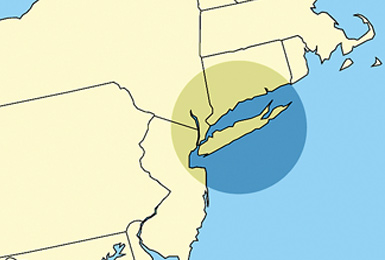Regional Innovation Cluster Leverages Long Island Institutions
Long Island, New York, will soon be home to a Regional Innovation Cluster (RIC) combining the resources of Stony Brook University, Brookhaven National Laboratory, and Cold Spring Harbor Laboratory.
March 2011

The project reflects an Obama administration strategy to establish RICs around the country that will stimulate business and the economy. In December, Congress reauthorized the COMPETES Act, which funds certain science, technology, and educational ventures. The act was expanded to include a new RIC Grant Program that will encourage cluster development nationwide, and especially the commercialization of new technologies and research.
The Program
Schumer targeted Suffolk County for its existing institutions that have a history of achieving scientific breakthroughs.
"Long Island is home to three of the greatest research institutions in the country, and by combining their efforts in the development of cutting-edge research and technologies, these institutions have the potential to create a jobs juggernaut for Long Island," Schumer said.
Stony Brook research supported the development of MRI machines, Brookhaven work has resulted in six Nobel prizes, and Cold Spring Harbor scientists unlocked DNA's molecular structure.
The institutions are already applying for funding from the new RIC Grant Program, as well as the National Science Foundation's Science and Technology Centers Grant Program. The latter offers up to $25 million to new research centers.
Local Perspectives
The town of Riverhead hopes the RIC will revitalize the Enterprise Park at Calverton (EPCAL), a 2,900-acre development that was home to a Grumman Corporation Navy aircraft final assembly and flight-testing center until 1996. Town Supervisor Sean Walter says the site - with commercial and industrial zoning and extensive existing infrastructure - is ideal for the RIC.
Walter is developing a reuse plan with a defined set of development criteria that will be presided over by a state-legislated entity. "If your plan met with the reuse plan's criteria, you would get immediate approval. That makes us competitive. That will be intriguing for entrepreneurs."
In Brookhaven, Town Supervisor Mark Lesko anticipates growth from the RIC, as well as an additional partnership called Accelerate Long Island that includes Brookhaven National Lab. "What we are talking about is not new or revolutionary, but we now have a missing piece of the puzzle that can accelerate the connection of entrepreneurs to our research assets," Lesko says.
Business advocates are also involved. The Long Island Association (LIA) is the state's largest business organization and plans to help coordinate the RIC. "These three institutions are assets that any other area of country would die for," says Kevin Law, LIA president and CEO. "We need to capitalize on those institutions."
Suffolk County Commissioner of Economic Development Yves Michel is already planning the department's assistance in locating employees and sites. He expects the RIC to boost local business confidence in the short term and to greatly expand the regional economy in the long term.
"We can harness our assets that are currently here to go a lot farther," Michel says. "More importantly, to go a lot faster. The time to do this is now."


